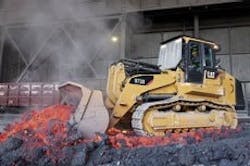Earthmoving Report: Caterpillar 973D C
Mike Anderson, Senior Editor
Last summer, Ken Nebergall was champing the bit. During an interview with Construction Equipment for a Buying File feature on crawler loaders, Nebergall was enthusing about the Caterpillar 953D and 963D models out in the market . . . and couldn't stop there. "And we can start talking about the 973D," he offered. "A lot of the same features and benefits that we built into the smaller D-Series machines are also incorporated into the 973 size."
At that point, a formal introduction was "coming soon" for a D-Series version of the Caterpillar 973, the largest crawler loader model on the market. With the arrival of 2010, so finally came that product introduction.
Completing the Caterpillar D-Series "track" loader lineup, the 973D newly features load-sensing hydraulics, joystick steering, an updated and tilting operator's station, and 10-percent more engine power than the predecessor 973C. Again powered by a Cat C9 ACERT diesel engine, but increased from 242 to 263 net horsepower, the 973D retains the hydrostatic drive, single-fabrication mainframe, Z-bar loader linkage and oscillating undercarriage of the "one-machine workforce" legacy of the 973C.
"The folks I talk to when I travel, they swear by track loaders," says Dave Cusac, track-type tractor product application specialist with Caterpillar's excavation and earthmoving divisions, "and it's all about keeping the rest of their fleets utilized. If they're moving bedding material and they just had a day or two of rain, 6 psi is a lot better than 30 psi, when you're looking at track ground pressure versus wheels, and still keeping up and keeping some of those other machines moving. It was very clear that those folks are very passionate about their usage of track loaders."
Supporting its tough large-machine stature, the 61,857-pound 973D is available in two waste-handling packages and a steel-mill package, utilizing the 74 additional horsepower it has over the next-largest crawler loader model available.
However, it's not only harsh-application contractors or the traditional basement diggers who can benefit from the crawler loader, but any operator who accepts "how productive they can be with this big skid-steer loader," says Cusac's colleague Nebergall, who uses the compact loader reference quite deliberately. "I think most of our customers all over the U.S. and the world understand the value of those products," he explains. "Well, when you look at the current track loader – our 953D, 963D and the 973D – you can very easily visualize that it's a larger and more productive version of those smaller machines."
And the recent product developments will only help in the understanding, says Nebergall, tractor-type tractor and track loader product sales engineer with Caterpillar's earthmoving division. "The joystick steering system is a new option that allows the newer, younger operator to get on and learn this machine very quickly," he says, "or if he's already been running one of these compact track loaders or skid steers, he already knows those controls."
The 973D's new closed-center implement hydraulic system uses a variable-displacement pump that produces only the required amount oil for the task. The lift and tilt cylinders use position-sensing electronics, allowing the operator to program kick-outs for faster cycle times.
